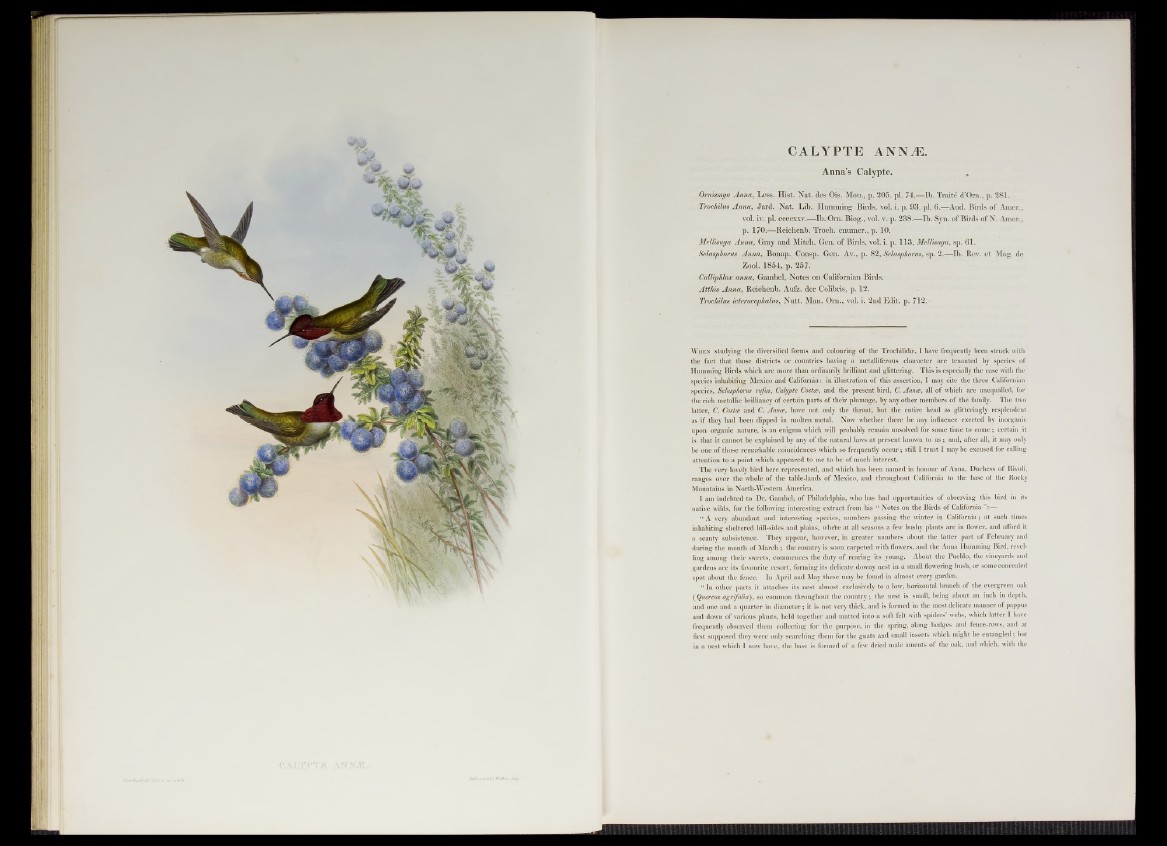
CALYPTE ANNÆ.
Anna’s Calypte. ,
Ornisniya Anna, Less. Hist. Nat. des Ois. Mou., p. 205. pl. 74.—Ib. Traité d’Orn., p. 281.
Trochïlns Anna, Jard. Nat. Lib. Humming Birds, vol. i. p. 93. pl. 6.—Aud. Birds o f Amer.,
vol. iv. pl. ccccxxv.—Ib. Om. Biog., vol. v. p. 238.— Ib. Syn. of Birds of N. Amer.,
p. 170.—Reichenb. Trocli. enumer., p. 10.
Mellisuga Anna, Gray and Mitch. Gen. o f Birds, vol. i. p. 113, Mellisuga, sp. 61.
Selasphonis Anna, Bonap. Consp. Gen. Av., p. 82, Selasphorus, sp. 2.—Ib. Rev. et Mag. de
Zool. 1854, p. 257.
Calliphlox anna, Gambel, Notes on Californian Birds.
Atthis Anna, Reichenb. Aufz. der Colibris, p. 12.
Trochilus icterocephalus, Nutt. Man. Om., vol. i. 2nd Edit. p. 712. •
W h e n studying the diversified forms and colouring of the Trochiliche, I have frequently been struck with
the fact that those districts or countries having a metalliferous character are tenanted hy species of
Humming Birds which are more than ordinarily brilliant and glittering. This is especially the case with the
species inhabiting Mexico and California: in illustration of this assertion, I may cite the three Californian
species, Selasphorus rufus, Calypte Costa, and the present bird, C. Anna, all of which are unequalled, for
the rich metallic brilliancy of certain parts of their plumage, hy any other members of the family. The two
latter, C. Costa and C. Anna, have not only the throat, hut the entire head as glifteringly resplendent
as if they had been dipped in molten metal. Now whether there be any influence exerted by inorganic
upon organic nature, is an enigma which will probably remain unsolved for some time to come ; certain it
is that it cannot be explained by any of the natural laws at present known to us; and, after all, it may only
be one of those remarkable coincidences which so frequently occur; still I trust I may be excused for calling
attention to a point which appeared to me to be of much interest.
The very lovely bird here represented, and which has been named in honour of Anna, Duchess of Rivoli,
ranges over the whole of the table-lands of Mexico, and throughout California to the base of the Rocky
Mountains in North-Western America.
I am indebted to Dr. Gambel, of Philadelphia, who has had opportunities of observing this bird in its
native wilds, for the following interesting extract from his “ Notes on the Birds of California —
“ A very abundant and interesting species, numbers passing the winter in California; at such times
inhabiting sheltered liill-sides and plains, wheVe at all seasons a few bushy plants are in flower, and afford it
a scanty subsistence. They appear, however, in greater numbers about the latter part of February and
during the month of March ; the country is soon carpeted with flowers, and the Anna Humming Bird, revelling
among their sweets, commences the duty of rearing its young. About the Pueblo, the vineyards and
gardens are its favourite resort, forming its delicate downy nest in a small flowering bush, or some concealed
spot about the fence. In April and May these may be found in almost every garden.
“ In other parts it attaches its nest almost exclusively to a low, horizontal branch of the evergreen oak
( Qitereus agrifolia), so common throughout the country ; the nest is small, being about an inch in depth,
and one and a quarter in diameter; it is not very thick, and is formed in the most delicate manner of pappus
and down of various plants, held together and matted into a soft felt with spiders’ webs, which latter I have
frequently observed them collecting for the purpose, in the spring, along hedges and fence-rows, and at
first supposed they were only searching them for the gnats and small insects which might be entangled; but
in a nest which I now have, the base is formed of a few dried male aments of the oak, and which, with the